When you think of the word meditation, what comes to mind?
If you’re just starting your meditation journey, you might be trying to balance your chakras (whatever that means!) or learning how to pronounce Ayurveda without sounding like you’re totally new at this.
While it’s easy to get caught up in all the confusing jargon, practicing meditation is actually quite simple.
Meditation is known for bringing a sense of peace and clarity to a person’s life. It allows you to pause, reflect, and reconnect with yourself by cutting out all of the noise and other distractions.
No matter what industry you’re in, meditation can be a helpful practice for you and your clients. You may think meditation style quizzes can only be used by health coaches or bloggers, but we’ll show you how easy and delightful it can be to incorporate meditation into your quiz.
Not convinced yet? Keep reading. We have a feeling you will be soon!
As you continue through this article, you’ll learn more about writing a meditation quiz, but if you see a specific section that makes you want to jump ahead, feel free to go there now:
- What is meditation?
- What are the benefits of meditation?
- Different types of meditation
- Why should I use meditation as a quiz topic?
- Industries that can use a meditation style quiz
- How to write a meditation style quiz
- 4 examples of a meditation style quiz
For the rest of us, let’s keep going and learn more about what meditation even is, why it’s beneficial for just about every human, and how it can positively change our brains forever. Hey, science says this—not just us! Plus, you’ll learn why meditation is a great quiz topic for so many businesses.
What is meditation?
When you picture someone who regularly meditates, you might visualize the stereotypical guy with a long beard and loose clothes who sits on a map and stays quiet for hours. Perhaps for you, it’s the woman wearing a tight athleisure outfit who does yoga and meditates by the beach at six o’clock every morning.
While these are the images we see in the movies and on social media, it’s not an accurate picture of what meditation really looks like. Sometimes it can be the mom who spends ten minutes meditating before her kids wake up, or the college student who needs to calm their anxieties about an upcoming exam with a meditation exercise.
No matter where you are in life, meditation can help you become more mindful every day—but first, let’s make sure we understand what meditation is.
Meditation gives you the ability to “be present, to rest in the here and now, and fully engage with whatever [you’re] doing in the moment,” as Headspace describes. It is a skill that can be learned over time. Some find meditation difficult because it requires a high level of focus, but it gets easier with practice.
So, why should you care about meditation, and what can it do for you?
What are the benefits of meditation?
Since there are three times as many people meditating now as compared to the last decade, there’s no doubt that meditation has become a popular wellness topic. However, it’s more than a trend or passing fad.
With influencers like Gabrielle Bernstein and Deepak Chopra touting its positive effects—and digital publications like Zen Habits and Mindworks giving millions of readers their best meditation tips—meditation is here to stay.
Meditation allows you to reconnect with your body and mind, giving you time to pause and get rid of any distractions. Whether you go through guided meditation or meditate on your own, there are dozens of benefits to doing so.
Meditation can decrease anxiety by up to 60% when it is practiced regularly. If you find yourself routinely stressed at work or in your personal life, meditating may help you reduce your stress levels so you can show up as your best self.
You’ve probably heard influencers say they start their mornings with meditation, but did you know meditation also has positive effects when practiced at night? If you struggle with insomnia, meditation can reduce your wake time by 50%, according to The National Center for Biotechnology Information.
If you have trouble falling asleep or feeling awake in the mornings, meditation could be worth a try. In addition to sleep and replenishing your energy, meditation can also help with back pain, PTSD, and lowering blood pressure.
In short, meditation can do wonders for your mind and body by connecting the two in a positive way. Instead of beginning your day feeling rushed or ending your day feeling anxious, meditation can help you refocus your attention and recenter yourself, leading to better rest, energy, and relaxation.
If you’re convinced it’s time to try meditation or start meditating regularly, you might be wondering where to begin. The first step is to understand the main types of meditation.
Different types of meditation
While there are many meditation types, let’s cover some of the most common practices to consider for your interactive quiz.
Guided meditation: Guided meditations are an easy place to start for beginners. A narrator’s voice will guide you through a series of exercises and instructions. There are many meditation apps that can help you get started, like Calm and Headspace, to name a few.
Mindfulness meditation: Originating from Buddhist teachings, mindfulness meditations have increased in practice among religious and non-religious individuals. In this type of meditation, you’ll be instructed to pay attention to your thoughts but must resist judging them. Your job is simply to observe your thoughts and note any patterns. This can easily be practiced alone, but teachers can guide you through this meditation type.
Focused meditation: Practicing focused meditation is interesting because it will engage your five senses. This meditation type aims to focus your attention on something internal, like your breath, or something external that helps you relax. If your mind starts to wander, don’t worry! You can simply refocus your attention and continue meditating.
Visualization meditation: This type of meditation is increasing in popularity because of its accessibility. Commonly used at in-person events and in entrepreneurial circles, visualization meditations allow a meditator to clear their mind and visualize positive scenes. While it can be used to reflect on the past, many teachers encourage meditators to visualize scenes of what they desire for the future. Tony Robbins is one of many who do this regularly to reset their goals and emotions for the day.
Spiritual meditation: Many people who meditate do so for religious purposes, which is why spiritual meditation is one of the most popular types. It is typically used by believers of Hindu, Buddhist, and Christian faiths, but it can be beneficial to anyone open to exploring their spirituality. Spiritual meditation can be done at home or in a place of worship for people who seek spiritual growth.
Loving-kindness meditation: You’ve probably heard of the importance of self-love and self-care. Loving-kindness meditations give you a quiet and safe place to explore these practices. This meditation type exists to help you extend feelings of love, compassion, and acceptance toward yourself, while helping you clarify your own sense of worth.
Body scan meditation: Just as it sounds, a body scan meditation is focused on syncing your mind with your body. You’ll do this as you perform a mental scan from the top of your head to the bottom of your feet. It is meant to identify any tension or aches in your body as you explore where they may be coming from.
After reading through this list, do you find yourself gravitating toward some meditation types more than others? That’s only natural! Our best advice is to start with the meditation type you feel most inspired by and see how it works for you.
You’ll soon see why many people consider meditation a lifestyle choice rather than a simple habit or activity. Since these meditation types can be hugely beneficial to people of all backgrounds and interests, let’s talk more about using them in a personality quiz.
Why should I use meditation as a quiz topic?
It’s been estimated that there are anywhere from 200 to 500 million people who meditate worldwide. Not only does this show the validity of meditation as a quiz topic, but it also shows the opportunity you have to reach people and bring meditation practices to new audiences.
Since meditation is considered a pillar of wellness, this quiz topic is a great fit for anyone who works, educates, or practices in a health-related field. However, this topic can also be used in other industries to engage with potential customers and clients. We’ll discuss that next.
Industries that can use a meditation style quiz
It’s fairly obvious why meditation would work in a quiz for people who work in health, but what about other industries? You may be surprised just how many content creators could write a meditation style quiz for their audience, even outside of health coaches and healthcare professionals.
Sleep coaches: Since meditation can help people fall asleep or reduce insomnia, it’s a great quiz topic for sleep educators and coaches. This can look like tried-and-true meditation techniques for sleep training kids or relaxing music with guided meditation to help anyone fall asleep. The possibilities are endless!
Nutritionists: For nutritionists to do their best work, they must look outside of someone’s diet to understand how their habits affect their physical health. Meditation can be introduced as a positive practice to clients who are struggling with their health.
Business coaches: When business coaches cover leadership and mindsets, meditation can become a natural part of the conversation. Of all the meditation types, visualization meditations and guided meditations are the most common in this field. Meditation can help these clients discover their voice, clarify their desires, and cultivate a practice that helps them slow down after working in hustle mode.
Life coaches: This may not come as a surprise since life coaches often help their clients focus on personal development, but meditation can be a great quiz topic for them to introduce in their programs. Meditation increases self-acceptance and self-understanding, which aids in each client’s journey toward self-discovery.
Essential oil influencers: Many bloggers partner with essential oil distributors, like Young Living and doTERRA. Essential oils are frequently used in meditation, so it makes sense to incorporate this lifestyle-focused topic into an overall content strategy.
Artists: Did you know that many artists practice meditation and mindfulness as they create their artwork? The Washington Post went as far as to call art “the new meditation.” With entire studios and online brands dedicated to blending art with meditation, it isn’t surprising for artists to make our list.
Relationship coaches: In the heat of an argument or disagreement, meditation may be what couples and friends need to recenter themselves. Mindfulness meditations have been found to decrease defensiveness, minimize overreactions, and reduce stress in couples. Pairing relationship coaching with meditation is a no brainer!
Course creators: No matter what course creators are teaching, helping students ease into content with a guided meditation could be a great method. By presenting students with a quiz, a course creator can help them eliminate distractions and calm their minds with meditation.
Is this opening your mind to how you can use a meditation style quiz? We hope so! As you continue exploring what this could look like for you, here are a few of our best tips on writing your own meditation quiz.
How to write a meditation style quiz
It’s important to choose a style of quiz that aligns with your goals. Think about why you want to incorporate meditation into your quiz and how it will help your audience accomplish something they desire. Then you can determine a quiz type that fits these goals.
You’ll find an explanation of the main quiz types in this article, but keep in mind that personality quizzes are the most popular.
Personality quizzes help people increase self-awareness and give them insights they may never have otherwise found. This will create a strong bond of trust between the quiz-taker and your brand, which in turn leads to more conversions and sales.
Buzzfeed frequently uses personality quizzes, and they also happen to be the most viral! Because quiz-takers are already so familiar with them, we usually recommend first-time quiz creators start with a personality quiz. If that sounds like you, here are your next steps…
Choose a quiz title and topic
The first thing you’ll need to do is choose a quiz topic. Do you want meditation to be the core theme of your quiz, or do you want it to be something you cover within the quiz? Hopefully, your topic will come easily to you now that you’re up to date on the most popular meditation types.
Next, it’s time to choose a title. People will see your quiz title before they decide whether or not to take your quiz. Create an engaging, interesting quiz title that asks a question they want to have answered.
This is why we recommend writing your quiz title in the form of a question. Instead of writing a quiz title like “Find Out Your Well-at-Work Meditation Style,” you could slightly tweak it to say “What Is Your Well-at-Work Meditation Style?” Much better!
Here are a few other quiz titles you can use or edit to fit your unique quiz:
- What Is Your Meditation Archetype?
- What Does Your Meditation Type Say About You?
- What Meditation Are You Missing Out On?
- What Meditation Style Fits You Best?
- Where Should You Begin with Meditation?
- What Do You Need to Know About Meditation?
- How Much Do You Know About Meditation?
Once you have a quiz title, write a very short summary of what your audience can expect when they take your quiz. We call this summary your “quiz description,” and it will be placed right underneath your title and main quiz cover image. Inside the Interact quiz builder in your free account, it will look something like this:

Create quiz result types
You might think it’s time to write your quiz questions and answers, since that’s the next thing your audience will see when they click the “take quiz” button, but we actually need to define something else first. We’re talking about your quiz result types.
For a personality quiz, we often call these the personality results. Each result will come with its own description that outlines what sets it apart from the rest.
Be as specific as you can without alienating people in your audience. If the description is too general, it will seem suitable for anyone, making it feel less special or not tailored to your quiz-taker. Our goal is for quiz-takers to feel like their personality result fits them perfectly and that you understand them deeply.
When you try to decide on your quiz result types, choose three to five main types so you don’t make too much work for yourself (like Kaye Putnam did with her 12 quiz results!). Then, you’ll be able to write descriptions based on the strengths, weaknesses, habits, and traits of each type.
Below is an example of a quiz description based on a template you can use for your own personality result types.
You are known for being [Blank] and [Blank], always [Blank]. No wonder your meditation style is a [Blank]! Since you tend to struggle with [Blank] and [Blank], your meditation style will help you [Blank]. To learn more, check your inbox for tips to get started with your first [Blank] meditation!
When you upload this information into your Interact account, it will look like this:
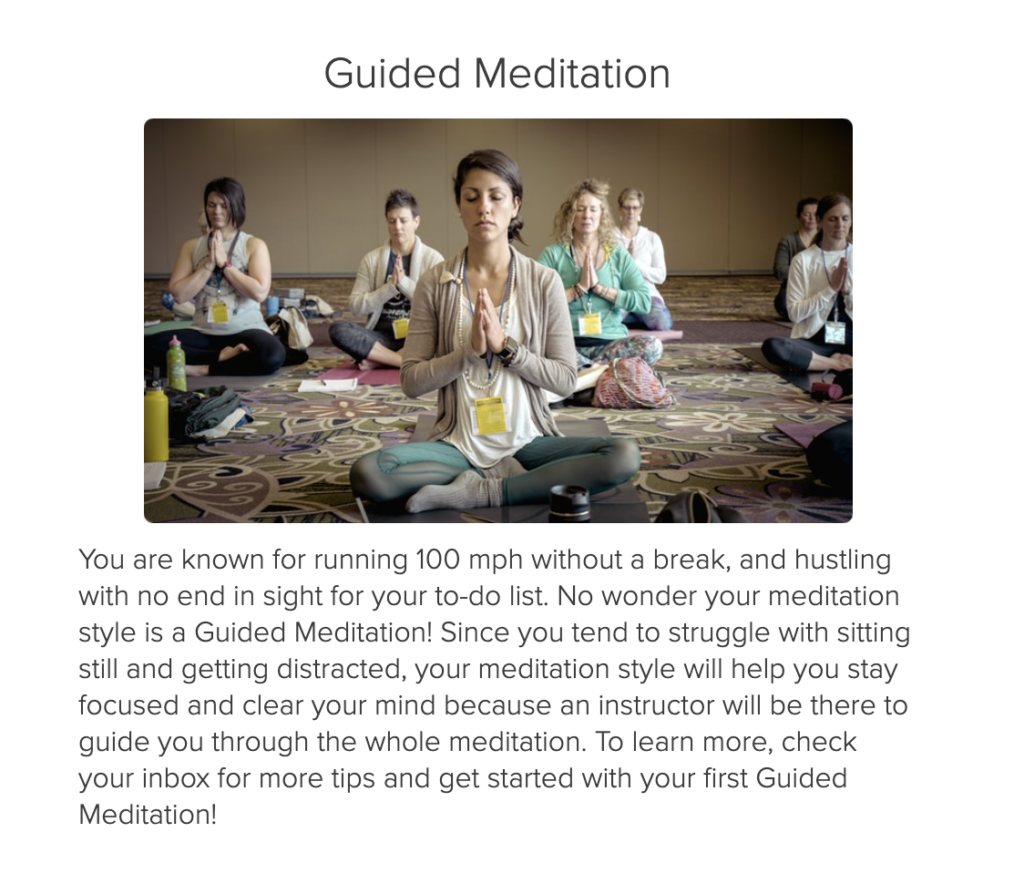
Easier than you thought, right? Complete these steps for the rest of your result types until they’ve all been created.
If you need more assistance with creating your quiz results, here are some helpful resources:
- How to Write Quiz Results
- How to Create Customer Personas for Your Personality Quiz
- How to Write a Personality Quiz for Business Results
Now that you have some momentum built up, let’s keep going with the next step!
Write quiz questions and answers
With your quiz result types in mind, you can finally tackle this task!
Brainstorm a list of questions you might want to ask in your quiz. Start by putting fifteen or so minutes on a timer and then list anything that comes to mind.
This is not your time to edit or reflect on what you write. Just let your thoughts flow, much like you do when you’re meditating. Once you’ve finished, go back through your list and mark the ones you want to use.
As you do this activity, think about the kinds of questions your audience asks you frequently. This may be a sign of what they want to learn more about. Another thing to consider is what you want to be seen as an expert in, and how you can weave those themes in your quiz.
Lastly, ask yourself what kind of data you’d like to collect from the quiz. That’s one of the best parts about creating a quiz: you get to see how your audience answers each question! Instead of sending a survey or spending hours interviewing your audience, you can give them the option of taking a quiz, which will give you similar (or even better) data.
We recommend using seven to ten quiz questions. That way, people stay engaged without checking out and your quiz is long enough to give accurate results.
If you need more help, our ultimate guide to writing quiz questions and answers from scratch is well worth the read, but you may also benefit from these other recommended resources:
- How to Ask Better Questions
- 50 Quiz Questions You Should Be Using
- 125+ True-or-False Questions To Challenge Your Audience
- 20 Personality Questions You Should Ask for Your Business
Since we’ve talked a lot about quiz questions, let’s briefly discuss how to come up with your quiz answers. What you may not realize is that having your quiz result types nailed down will make this process so much easier.
Let’s say one of the questions on your list asks your audience how they usually feel at the end of their workday.
To write the best answers for your quiz, you’ll want to create the same number of answer options as you have quiz result types. So, if you have three result types in your quiz, you’ll ideally have three answer options for each question.
With this reverse engineering, you’ll be able to look at each of your quiz result types and write answers that directly correlate with them. Here’s what it looks like in Interact:
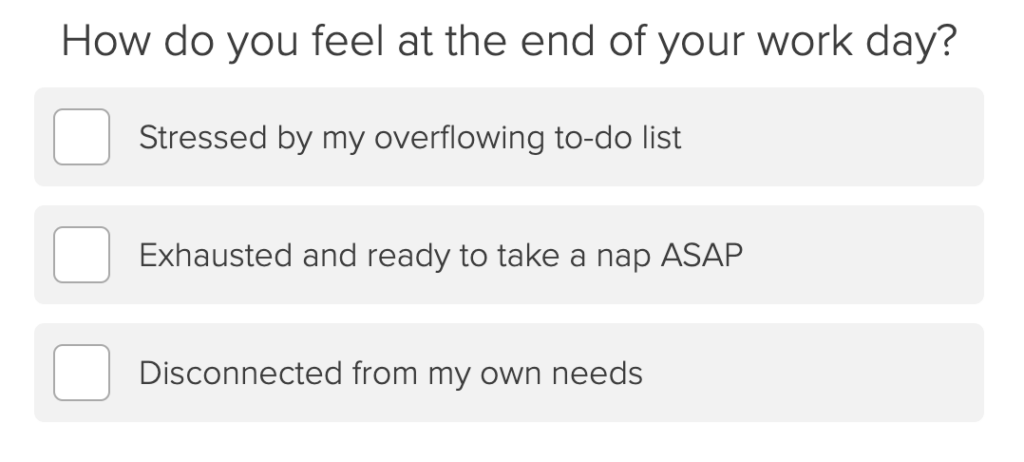
Now that your question and answers have been uploaded into our quiz-building platform, it’s time to edit the result correlations, which is a button on the right side of the options on the Questions screen.

When you click the correct answer and result for each option, you’ll notice a line of connection appear. This is what creates your quiz logic, which is simply a fancy way of showing exactly how each answer gets a quiz-taker closer or further away from a quiz result type. If you’ve ever wondered exactly how quizzes are built to automatically give accurate results, this is how!
Once you’ve completed these steps for every question and answer, you’re ready for the very last step. It will feel like a total breeze after the work you’ve put in so far!
Design and launch your quiz
To make sure your quiz is on-brand, use this time to customize the look and feel of your quiz. This could include changing your stock photos, graphics, colors, fonts, and more. In this stage, our Complete Guide to Quiz Design will be helpful.
Then you’ll be ready to publish your quiz! When it’s launched, you can embed it onto your website, create a unique page URL link on your site, and share it on social media.
If you want to take it one step further, we highly recommend creating a follow-up email sequence so you can continue to nurture your quiz leads. An email sequence of three to four emails won’t take long to create but will make a lasting impression with your new email subscribers. You can even drive more sales from your quiz! Take a peek at our quiz case studies to see how.
Not sure where to get started with your email sequence? Check out our four quiz-related email templates you can copy and paste into an email marketing platform of your choice. Just make sure to customize them with your own messaging!
Here are a few other resources to make your email sequence easier to write and launch:
- Why You Need an Email Marketing Strategy
- Complete List Building Guide (plus Email Templates)
- How to Build Your Email List Using Quizzes
- 21 Ways to Get More Email Subscribers Without Spending Money
Now that you know exactly how to write meditation style quizzes, you might want to gather other inspiration as you create your own. We’ve got you covered with a few quiz ideas that we’ll share next.
4 examples of a meditation quiz
We can’t wait to see what kind of meditation quiz you create with your free Interact account!
If you haven’t signed up yet, click here to get started. It will walk you through the process, or you can revisit this article to remind yourself of each step.
In the meantime, here are some of our favorite examples of meditation quizzes. These have all been collected from our quiz template library, which has thousands of quizzes you can customize. Feel free to edit or reuse them however you’d like!
“What style of meditation is right for you?” quiz
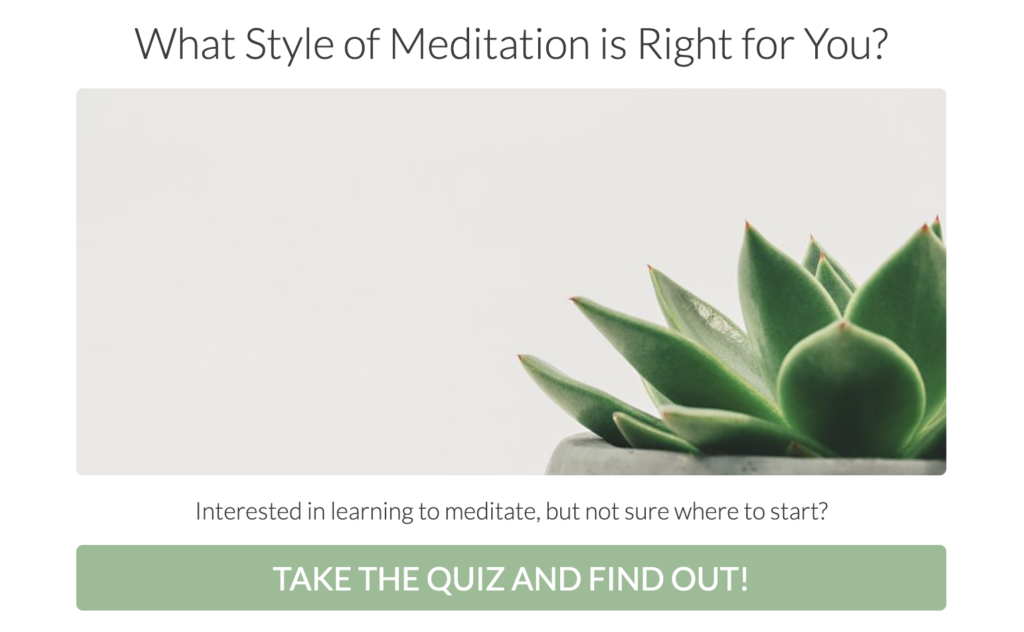
If you want to quiz your audience on the basics of meditation to better understand how much they already know, this quiz template could be a great fit.
After someone takes this quiz, they’ll receive a hand-picked meditation type to explore. Quiz-takers will walk away knowing what style of meditations are worth their time and how they’d benefit from them.
Sample questions from this quiz include:
- If you had one area you’d like to improve on, which one would you choose?
- What would help you maintain a meditation practice?
- What scares you most about meditation?
“Where should you start to reduce mental clutter?” quiz
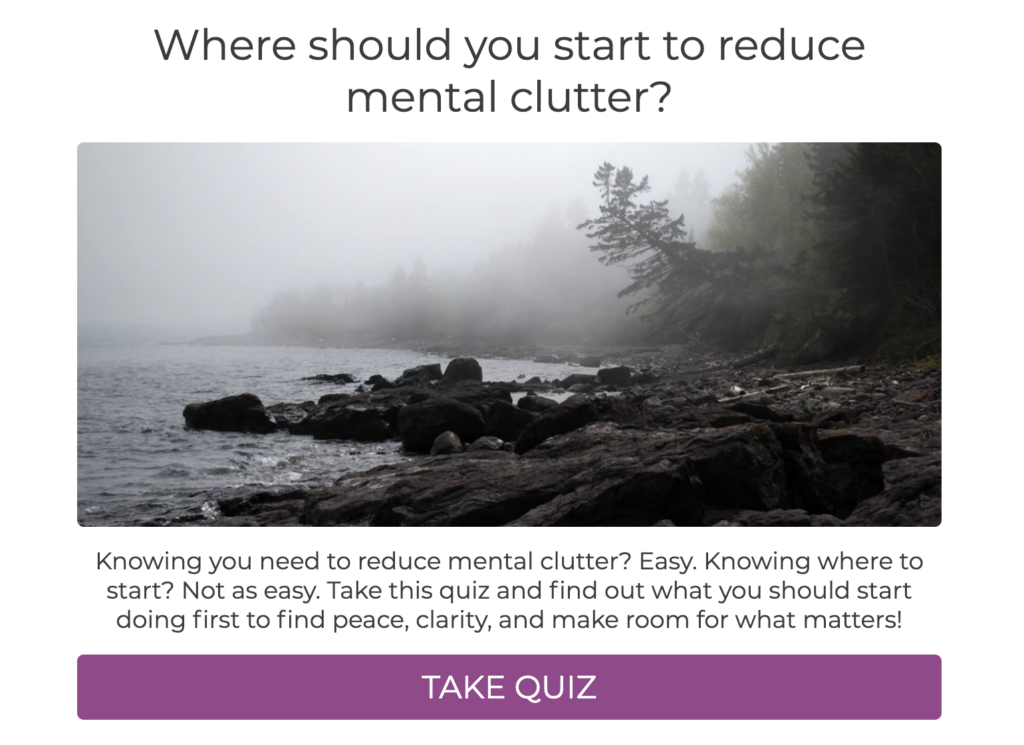
Reducing mental clutter is exactly what meditation helps with, so this quiz template could be easily adapted to fit your quiz topic. Since this topic focuses on helping quiz-takers find inner peace and clarity, meditation is a natural fit.
One of the quiz result types included in this template is Mindfulness, so you could include beginner meditation tips inside the result description or elsewhere in the quiz.
Sample questions from this quiz include:
- It’s way past your bedtime, but you’re still awake. What is keeping you up?
- You find yourself with some unexpected free time. What do you do?
- Where would your ideal vacation spot be?
“What is your overwhelm type?” quiz
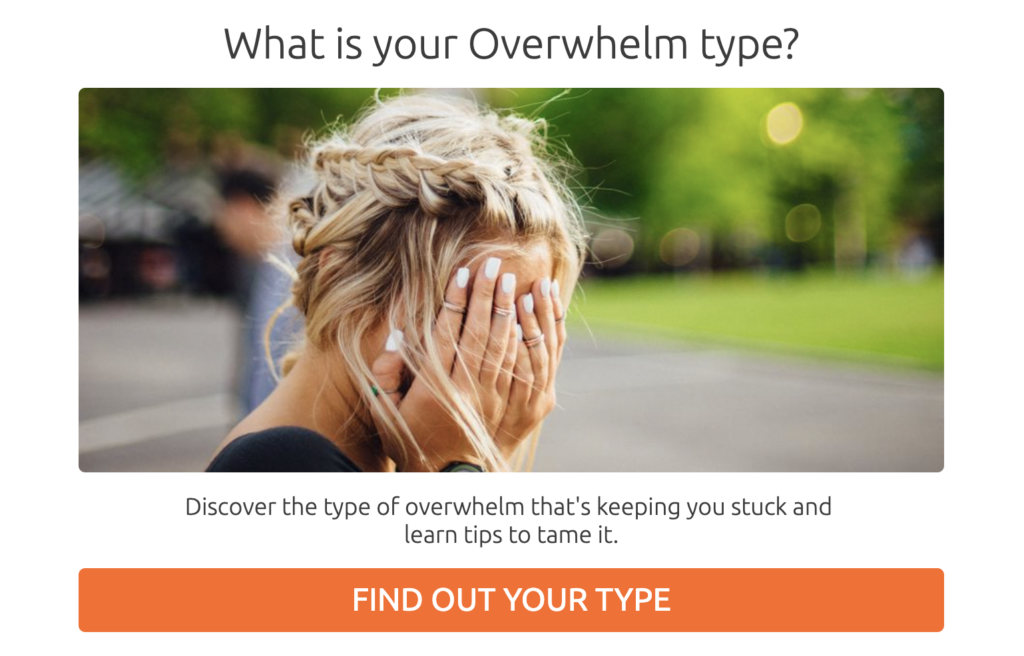
While this quiz template doesn’t mention meditation explicitly, it can easily be adapted. With result types like Productivity Pressure, Time Pressure, and Inner Critic, there’s no doubt these quiz-takers could benefit from meditation.
If you wanted to use this template, you could include a question in the quiz about meditation or simply include meditation types as recommended resources inside the quiz result descriptions. Get creative with it!
Sample questions from this quiz include:
- Which one of these is the biggest cause for celebration?
- When you look at the clock, you think…
- Your desk looks like…
“Are you headed for burnout?” quiz
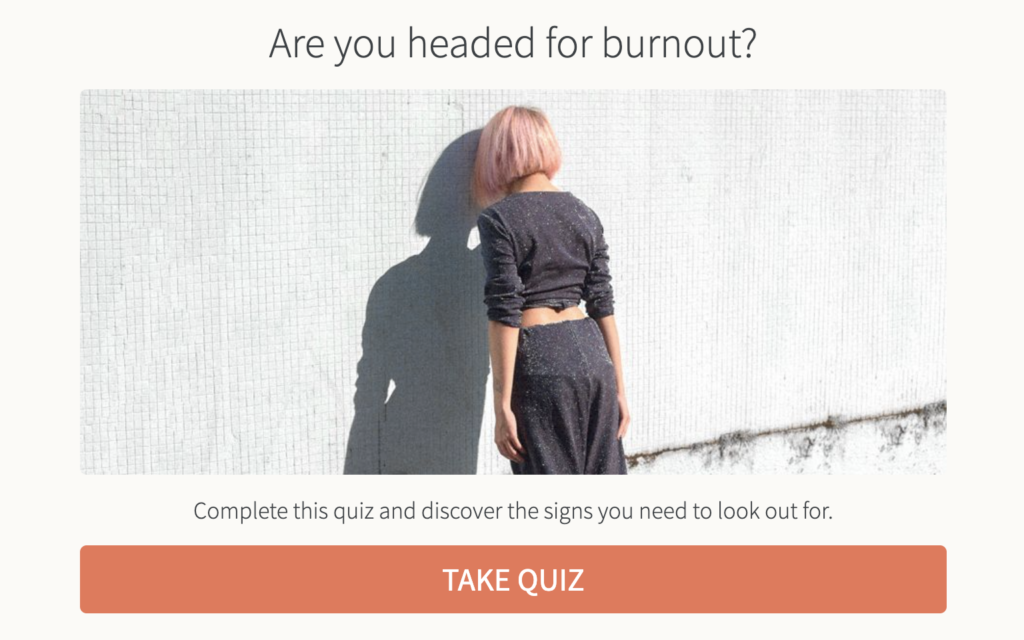
People who frequently feel burned out in their job or personal life could benefit greatly from mindfulness and meditation. This quiz template is designed to help people determine if they’re headed for a season of burnout and what to do if (or when) it happens.
This quiz is set up more like a scoring quiz than a personality quiz, but it might be a great fit for coaches or educators who want to help their clients identify where they currently are on the burnout scale. From here, you can recommend resources related to meditation or even provide audio recordings of your own guided meditations.
Sample questions from this quiz include:
- Does your health ever take a backseat due to work pressures?
- In the last month, how often have you felt anxious or overwhelmed?
- How often does work stress keep you awake or wake you up at night?
With new quiz inspiration, you’re now ready to start building your own quiz!